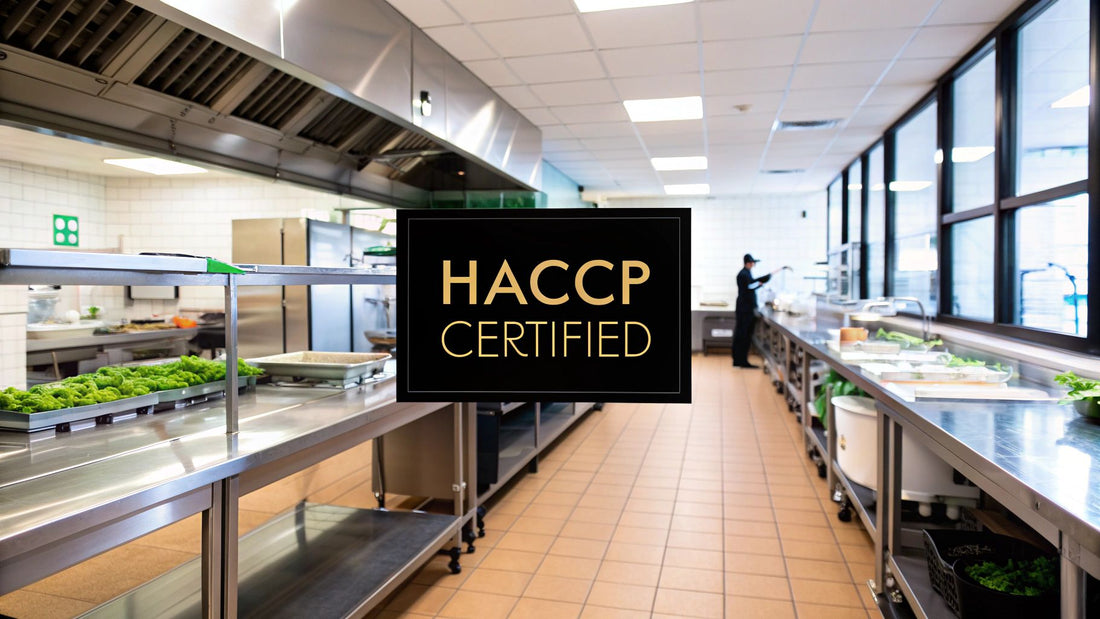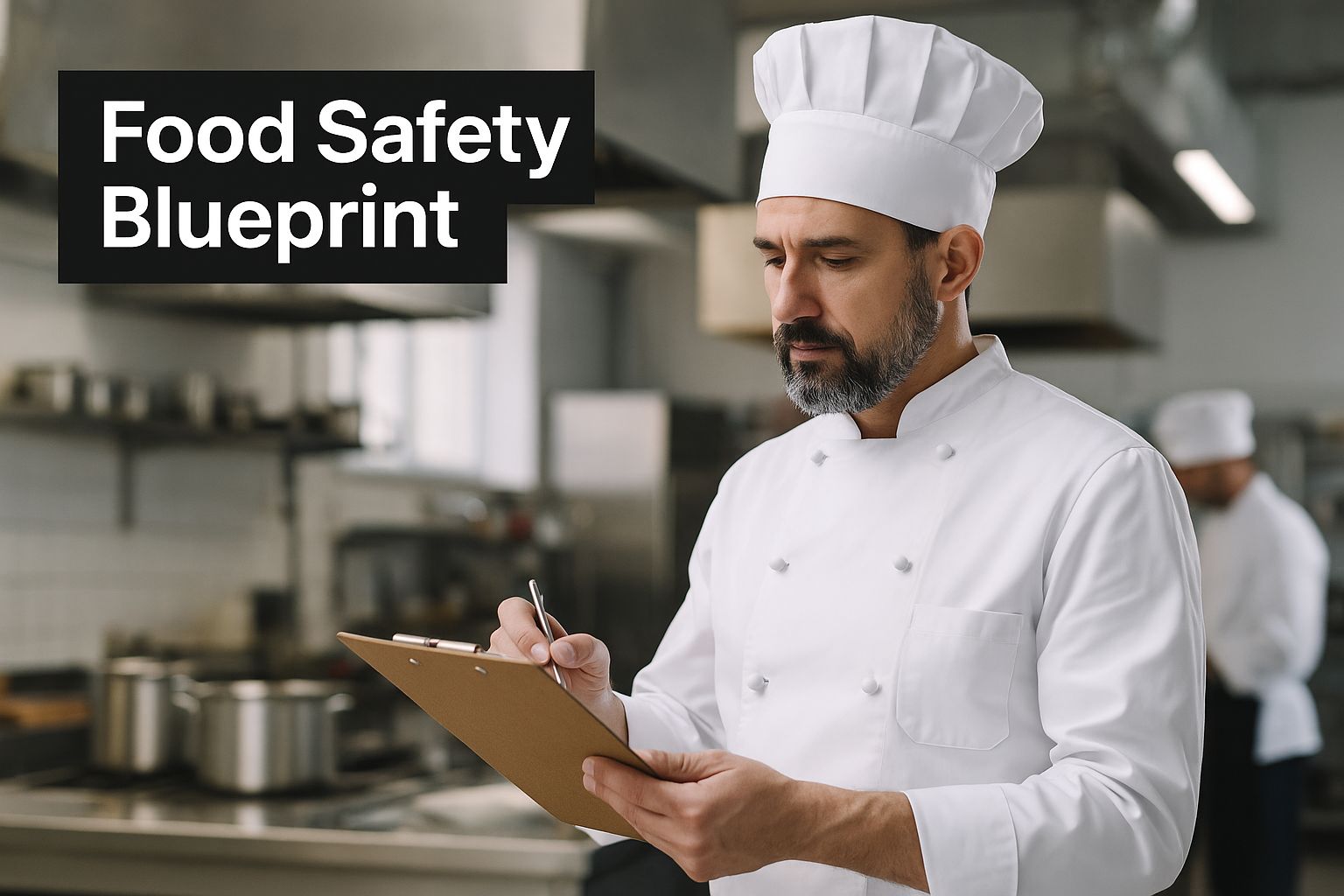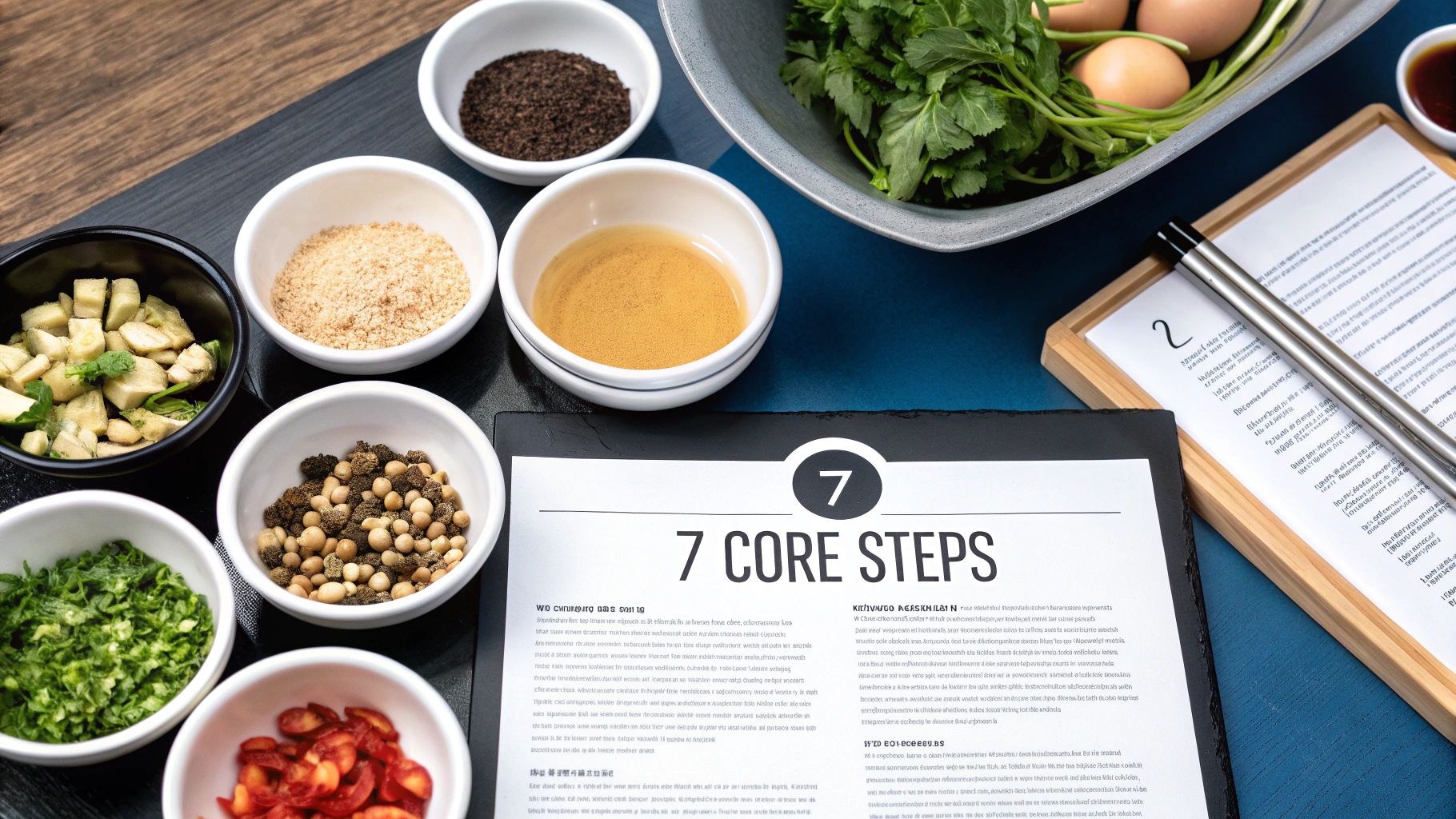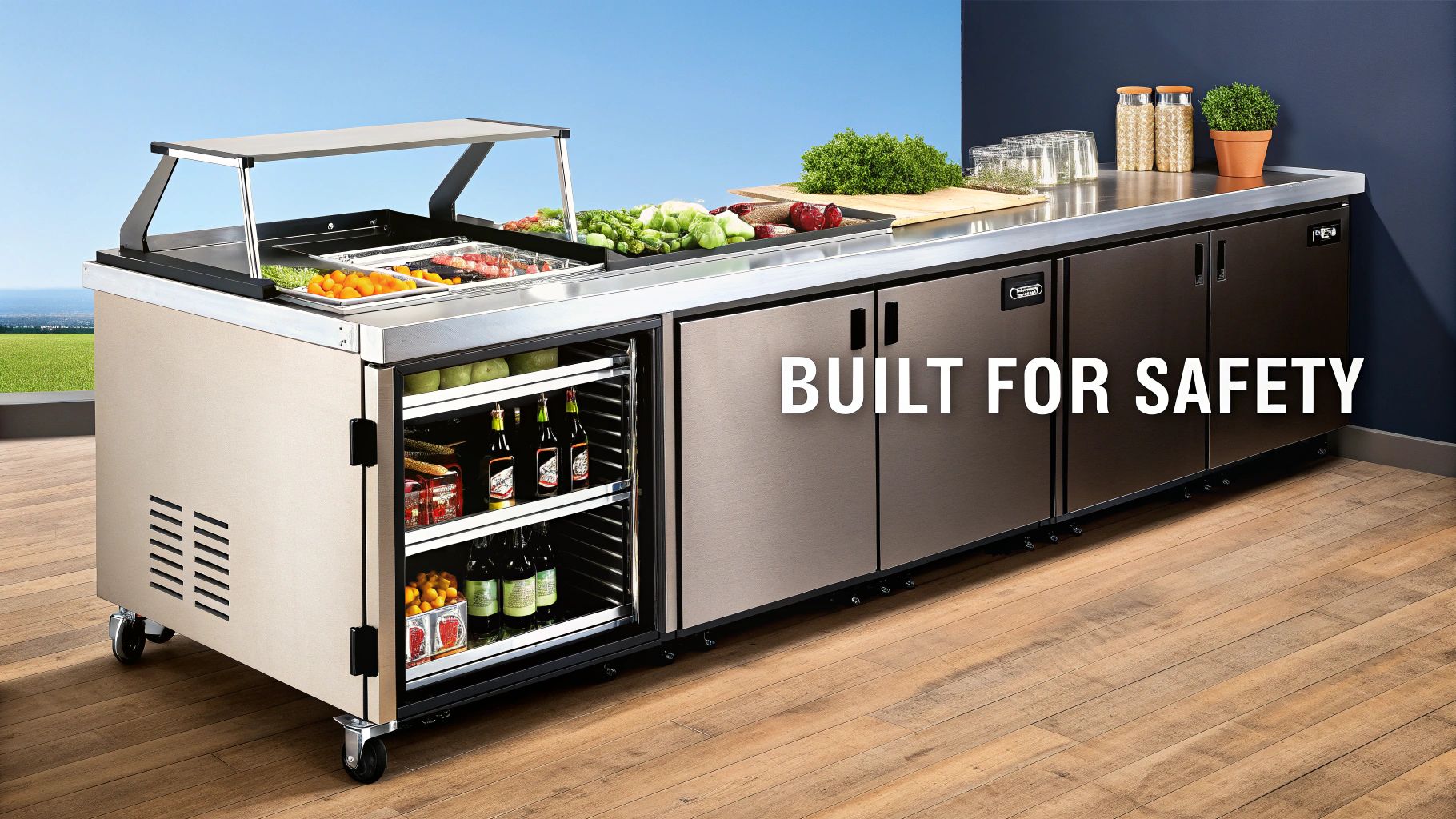
What Is HACCP Certification? Your Food Safety Guide
Share
If you've spent any time in a professional kitchen, you know that food safety isn't just about cleaning up spills. It's a mindset. That's where HACCP certification comes in—it’s a globally recognized system that completely changes the game from a reactive "clean it up" approach to a proactive "prevent it from happening" strategy.
Instead of just checking the final dish for problems, HACCP is about preventing hazards at every single step, from delivery to the final plate.
Unpacking the HACCP Food Safety Blueprint
Think of HACCP (Hazard Analysis and Critical Control Points) as the master blueprint for food safety in your kitchen. Rather than hoping you catch a problem before it reaches a customer, this system provides a solid framework. It helps you pinpoint and manage potential biological, chemical, and physical risks from the moment your ingredients arrive to the second a finished meal is served.
This preventive philosophy is what makes HACCP so powerful. It’s not an afterthought; it’s about weaving safety directly into your daily operations. It forces you to look at your entire workflow—receiving, storing, prepping, cooking—and turn food safety into a deliberate, repeatable process.
Shifting from Reaction to Prevention
The old way of handling food safety was often about damage control—reacting to contamination after it already happened. HACCP flips that model completely.
- Proactive Hazard Identification: It makes you systematically hunt for potential risks before they ever get a chance to cause harm.
- Focus on Control: It establishes non-negotiable control points, like precise cooking temperatures or refrigeration levels, that are absolutely critical for safety.
- Continuous Monitoring: It builds a system of ongoing checks and balances to make sure your safety rules are being followed, every single shift.
This infographic does a great job of showing how HACCP acts as the core safety plan for any serious kitchen.

Just like the image shows, a solid plan is the foundation of a safe, smooth-running kitchen. And this structured approach is good for business, too. The global food certification market is expected to hit USD 9,632.7 million by 2034, largely because customers are demanding more transparency and safety from where they eat.
HACCP isn't just a list of rules. It’s a management system designed to make food safety a core part of your kitchen's culture, protecting both your customers and your hard-earned reputation.
At the end of the day, understanding HACCP certification is the first step toward building a truly safe food environment. While HACCP is all about the process, other certifications—like those for your equipment—are just as important. You can learn more about equipment standards in our guide on what is NSF certification.
The 7 Core Principles of HACCP Demystified
The entire HACCP system is really built on seven core principles. Think of them less like rigid rules and more like a logical, step-by-step roadmap for creating a food safety plan that actually works. When you get a handle on these principles, you can shift food safety from being just another chore to something that’s woven into the very fabric of your kitchen's operations.
Let's walk through each one, using real-world kitchen examples to show you how they play out in a busy environment.

Principle 1: Conduct a Hazard Analysis
This is where it all begins—the foundation of your entire plan. Your team needs to get together and identify every potential biological, chemical, and physical hazard that could possibly pop up during your food production process. You're basically putting on your detective hat and asking, "What could go wrong here?"
For instance, a biological hazard is the obvious one, like Salmonella in raw chicken. A chemical hazard might be some leftover cleaning spray on a prep surface, and a physical hazard could be a tiny piece of plastic that chipped off a storage lid. This stage is all about a thorough brainstorm to map out every conceivable risk.
Principle 2: Identify Critical Control Points
Okay, so you've listed out all the potential dangers. Now you need to pinpoint the Critical Control Points (CCPs). A CCP is a specific step in your process where you have the power to step in and either prevent, eliminate, or reduce a food safety hazard to a safe level. It’s the make-or-break moment.
- Example: Cooking raw chicken is a classic CCP. If you don't hit the right internal temperature, there's no later step to kill off potential Salmonella.
- Non-Example: Seasoning that same piece of chicken is not a CCP for Salmonella. A dash of paprika isn't going to do anything to control the pathogen.
Getting your CCPs right is crucial. It helps you focus your time, energy, and resources on the moments that truly matter for safety.
Principle 3: Establish Critical Limits
Every CCP needs a critical limit. This is a clear, measurable boundary that tells you whether the control measure is working. Think of it as a non-negotiable line in the sand for safety.
These limits have to be based on science, not guesswork. For our chicken example, the critical limit is cooking it to a minimum internal temperature of 165°F (74°C) for at least 15 seconds. If that thermometer reads 164°F, it hasn't met the limit, and the food isn't considered safe yet.
Principle 4: Establish Monitoring Procedures
How do you actually know you're hitting those critical limits every single time? That's where monitoring comes in. You need to set up a system to regularly check and record what's happening at each CCP.
Monitoring gives you a real-time log of your process and acts as an early warning system. This could be as simple as:
- Using a calibrated probe thermometer to check the internal temp of every batch of chicken.
- Logging the walk-in cooler's temperature every two hours to make sure it's holding below 41°F (5°C).
- Doing a quick visual check of all food deliveries for signs of damage or spoilage before accepting them.
Principle 5: Establish Corrective Actions
Let's be real—even with the best plans, things go wrong. This principle is about deciding in advance what you'll do the moment monitoring shows a critical limit has been missed. These corrective actions need to be planned out, immediate, and effective.
If your temperature log shows a chicken breast only hit 155°F, your corrective action is simple: put it back in the oven until it reaches 165°F. If a prep fridge is running warm, the action is to move the food to a working unit and get maintenance on the phone immediately.
Principle 6: Establish Verification Procedures
Verification is all about stepping back and double-checking that your whole HACCP system is actually doing what it’s supposed to do. This goes beyond the daily monitoring. It involves things like reviewing your temperature logs from last week, periodically calibrating your thermometers, and observing staff to ensure they're following procedures correctly.
This step answers the big-picture question: "Is our safety plan working effectively, or are there holes we need to patch?"
Principle 7: Establish Record-Keeping Procedures
Last but not least, you have to document everything. Your records should include your initial hazard analysis, your list of CCPs, your critical limits, all monitoring data, and any corrective actions you took. Meticulous records are the only way to prove you’re consistently following your HACCP plan.
This paperwork isn't just for the health inspector. It’s a vital tool for troubleshooting when a problem arises and for continuously improving your own food safety systems. Without good records, you can’t prove your commitment to the what is haccp certification process.
To make this all a bit easier to digest, here's a quick summary of the seven principles in action.
The 7 Principles of HACCP at a Glance
| Principle Number | Principle Name | Simple Explanation | Kitchen Example |
|---|---|---|---|
| 1 | Hazard Analysis | Find anything that could make food unsafe. | Identifying that raw chicken can carry Salmonella. |
| 2 | Identify CCPs | Pinpoint the exact steps where you can control a hazard. | The cooking step is the CCP for killing Salmonella on chicken. |
| 3 | Establish Critical Limits | Set measurable safety targets for each CCP. | The chicken must be cooked to a minimum internal temperature of 165°F. |
| 4 | Establish Monitoring | Create a plan to regularly check that limits are being met. | Using a calibrated thermometer to check the temperature of every chicken breast. |
| 5 | Establish Corrective Actions | Decide in advance what to do if a limit isn't met. | If a chicken breast is only 160°F, the corrective action is to continue cooking it. |
| 6 | Establish Verification | Double-check that your whole system is working correctly. | The manager reviews temperature logs weekly and recalibrates thermometers monthly. |
| 7 | Establish Record-Keeping | Keep detailed written proof of everything. | Maintaining logs of all cooking temperatures, corrective actions, and thermometer calibrations. |
Seeing it all laid out like this really shows how each principle builds on the last, creating a comprehensive and logical system for keeping food safe from start to finish.
Bringing Your HACCP Plan to Life in the Kitchen
A well-written HACCP plan is a great start, but its true value is measured in the day-to-day operations of your kitchen. The seven principles only work when they become habits, seamlessly integrated into your workflow. This is where theory meets reality. It transforms your kitchen from a place that simply follows rules into an environment with a deep-rooted culture of food safety.
Let’s follow the journey of a single ingredient, like a case of fresh chicken breasts, to see how HACCP principles guide every step.
From Receiving Dock to Storage
The moment the delivery truck arrives, your HACCP plan kicks in. This is your first critical control point. Your receiving staff isn't just counting boxes; they are trained to act as the first line of defense.
- Temperature Check: They immediately use a calibrated thermometer to ensure the chicken is below the critical limit of 41°F (5°C).
- Visual Inspection: They check for signs of damage, torn packaging, or discoloration that could indicate a hazard.
- Labeling and Dating: Once accepted, every box is immediately labeled with the delivery date and a "use-by" date before being moved to the designated walk-in cooler.
This structured receiving process prevents potential hazards from ever entering your kitchen. It’s a simple but powerful workflow that stops problems right at the door.
Safe Preparation and Cooking Workflows
Once the chicken moves to the prep station, another set of HACCP-driven habits takes over. Cross-contamination is a major hazard, so workflows are designed to keep raw and ready-to-eat foods separate. This means using dedicated color-coded cutting boards and ensuring staff wash their hands and change gloves after handling the raw product.
The cooking stage is one of the most obvious critical control points. Your chefs know the critical limit isn't a suggestion—it's a rule. They use a probe thermometer to verify each piece of chicken reaches an internal temperature of 165°F (74°C). This temperature is logged, creating a verifiable record that the CCP was met.
A critical component of bringing your HACCP plan to life involves rigorous sanitation. Explore this comprehensive guide to cleaning commercial kitchens to ensure optimal hygiene.
Think of your HACCP plan as the kitchen's DNA. Consistent temperature logs, proper food labels, and diligent handwashing are the small, daily actions that build a strong, resilient food safety system.
Ultimately, these workflows turn the abstract principles of HACCP into tangible actions. By embedding these habits into every station—from receiving to serving—you create an environment where safety is an automatic reflex, not an extra chore. For more insights on this topic, check out our article on food safety and sanitation guidelines that every kitchen should follow.
Choosing Kitchen Equipment That Supports HACCP
Think of your kitchen equipment as more than just tools—they're active partners in your food safety program. A solid HACCP plan can be made or broken by the gear you use day in and day out. When you choose wisely, following your food safety rules becomes second nature, embedding compliance right into your daily workflow. This is especially true for your prep surfaces, where the real hands-on work happens.
Making smart equipment choices is becoming more important than ever. The industry is shifting towards integrating systems like HACCP with broader Food Safety Management Systems (FSMS) like ISO 22000. As things evolve, equipment that allows for real-time monitoring and data tracking is becoming the new standard.
The Foundation: Stainless Steel Prep Tables
When you’re talking about HACCP compliance, stainless steel is the undisputed champion for prep tables. Why? It all comes down to its non-porous surface. Unlike wood or some plastics, it gives bacteria nowhere to hide and doesn’t soak up moisture or smells. This makes it incredibly simple to clean and sanitize, which directly supports the hazard control principles of your plan.
These essential workhorses come in a few different styles, each built to handle specific kitchen challenges:
- Standard Work Tables: These are your straightforward, flat-topped tables, perfect for general prep tasks like chopping vegetables or portioning ingredients. They provide a clean, durable, and versatile surface.
- Tables with Backsplashes: An integrated backsplash is a simple but effective feature. It prevents food and liquids from splashing onto walls, which are harder to clean and can become contamination zones.
- Tables with Undershelves: Many tables come with an adjustable open shelf underneath for storing containers, small equipment, or dry goods. This keeps items off the floor, a key principle of kitchen sanitation.
- Enclosed Base Work Tables: These feature sliding or hinged doors, creating a sanitary cabinet for storing items away from dust and debris while keeping them close at hand.
If you want to get into the nitty-gritty of materials and features, check out our detailed guide on selecting the right commercial kitchen equipment.
Specialized Prep Tables for Critical Control Points
Moving beyond the basics, some equipment is specifically engineered to manage critical control points (CCPs) with total precision. Sandwich prep tables and pizza prep tables are perfect examples of equipment designed with HACCP built right in. Their main job is to maintain the cold chain—a huge CCP for stopping bacteria from growing on perishable foods.

These refrigerated prep stations aren't just about convenience; they are purpose-built to control the temperature danger zone. By keeping ingredients like meats, cheeses, and sauces consistently below 41°F (5°C), they make compliance almost automatic.
The very design of these units supports HACCP principles. You have refrigerated compartments below and chilled ingredient rails up top, ensuring everything stays at a safe temperature from start to finish. This drastically cuts down the time food spends in unsafe conditions, making your workflow smoother while embedding a critical safety control right into the equipment. Picking this kind of purpose-built table makes hitting your critical temperature limits a seamless part of your daily routine.
Your Path to Achieving HACCP Certification
Having a solid HACCP plan on paper is a massive first step, but getting it officially certified? That takes your commitment to a whole new level. The certification process is a structured journey that formalizes your food safety systems and gets them validated by an outside expert. It’s how you transform your internal guidelines into a recognized, provable standard of excellence.
The journey starts by building a dedicated team. Your HACCP team can't just be one person; it should include people from all corners of your operation—think head chef, kitchen manager, even a receiving clerk—to make sure every angle is covered. Their first job is to get granular: describe your food products in detail and map out every single step in your kitchen's workflow with a clear flow diagram. This visual map is the bedrock for applying the seven principles.
Turning Your Plan into Practice
Once your team and workflow are set, the real work begins. You'll start applying the seven principles we talked about earlier, which means conducting your hazard analysis, pinpointing your critical control points (CCPs), and setting firm, measurable critical limits for each one. This is where documentation becomes your best friend.
Meticulous records are the absolute backbone of a successful certification audit. You have to prove that you're consistently monitoring your CCPs, taking immediate corrective action when things go sideways, and regularly verifying that the entire system actually works. Staff training is just as crucial; every team member needs to understand their specific role in keeping the HACCP plan alive and well.
The Role of Third-Party Auditors
It's really important to understand the difference between just having an internal HACCP plan and achieving official HACCP certification. An internal plan is a great management tool, but certification demands validation from an accredited third-party auditor. This independent expert will comb through your documentation, watch your processes in action, and verify that your system meets all the required standards.
An auditor doesn't just look for a plan; they look for proof that the plan is a living, breathing part of your kitchen's daily culture. They verify that your records are accurate, your staff is trained, and your safety controls are consistently enforced.
To get through this process smoothly, you'll find it incredibly helpful to use robust audit and compliance checklists specifically for the food and beverage industry. These kinds of tools can help you get your documentation organized and feel truly prepared for the rigorous review.
Taking this structured path is quickly becoming a strategic move in the global food market. HACCP certification is surging as businesses aim to meet international standards. For instance, the Asia-Pacific region saw a 15% increase in facilities certified under international hygiene standards in recent years, all driven by a desire to tap into new markets and build consumer trust. You can learn more about the growth of the food certification market and its global impact. By breaking these steps into achievable milestones, you can navigate the path to certification with confidence.
Answering Your Top HACCP Questions
As you start to map out your own food safety plan, a few questions always seem to pop up. Getting straight answers is the best way to move forward and feel good about your process. Let's clear up some of the most common points of confusion around HACCP certification.
This final section gets into the nitty-gritty: the legal side, how long certification lasts, and how HACCP fits into the bigger picture of food safety.
Is HACCP Certification A Legal Requirement?
This is the big one, and the honest answer is: it depends. There's no single, universal law that says every food business everywhere needs HACCP certification. The rules really change depending on where you are and what kind of food you're working with.
For instance, in the U.S., the FDA makes HACCP plans mandatory for anyone processing juice or seafood. The USDA does the same for meat and poultry plants. But for a lot of restaurants or smaller food businesses, your local health department might require you to have a HACCP plan, while getting a third-party certification is often your choice.
The bottom line is to always, always check with your local regulatory authorities. They’re the ones who can give you the final word on what’s legally required for your specific business.
How Long Does a HACCP Certification Last?
Getting HACCP certified isn't a one-and-done deal. It’s more like an ongoing commitment to food safety, not a lifetime achievement award. Your certification is typically valid for a specific timeframe, usually somewhere between one and three years, based on who certifies you.
To keep that certification active, you'll have to go through regular surveillance audits. These are basically check-ins to make sure your HACCP system is still working as it should and that your team is sticking to the plan. These re-audits aren't just a formality; they're a core part of the system that keeps everyone sharp and focused on continuous improvement.
What’s The Difference Between HACCP and ISO 22000?
It's really easy to mix up HACCP with other food safety standards, especially ISO 22000. They're related, but they don't do the same job.
- HACCP is a hands-on, scientific system that zeros in on finding and controlling specific hazards right in the middle of your food production process. Think of it as the tactical game plan for stopping contamination before it starts.
- ISO 22000 is a much bigger-picture Food Safety Management System (FSMS). It actually includes all the principles of HACCP, but it also folds in other critical management pieces like communication plans, facility requirements, and a formal structure for continuous improvement.
Put simply, HACCP is a vital part of the larger ISO 22000 framework. You can be HACCP compliant without being ISO 22000 certified, but you absolutely cannot get ISO 22000 certified if you don't have a rock-solid HACCP system already in place. Knowing the difference helps you pick the right goal for your business.
At PrepTables.com, we know that great food safety starts with the right foundation. Our NSF-certified stainless steel tables and prep stations are built to make HACCP compliance simpler and more streamlined. Explore our collection of professional-grade kitchen equipment at https://preptables.com and start building a kitchen that’s as safe as it is productive.
